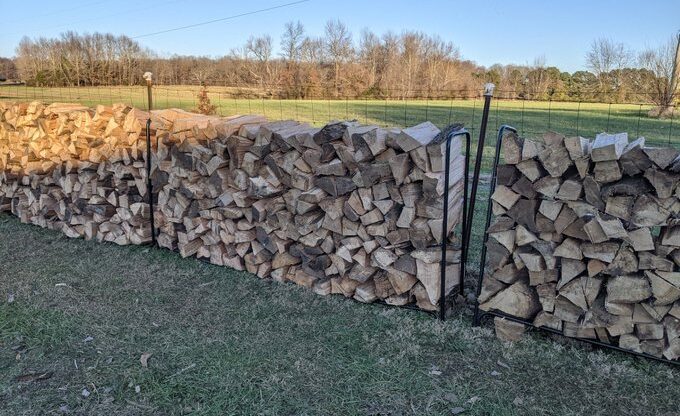Table of Contents
How firewood is measured and sold
Firewood is typically sold in ricks and cords. A rick is stack of firewood that’s 4ft tall and 8ft long. Split firewood is typically 16 inches or 24 inches long making a rick either 42 cubic feet or 64 cubic feet of wood. 16 inches is usually preferable as it’s easier to handle.
There are three ricks in a cord. Traditional guidance is that you need three cords of wood to heat a 1,000 sqft house for a winter. Obviously that varies by climate, insulation and any number of other factors.
Storing firewood
Firewood should be stored on racks that lift it off the ground which keeps moisture away from it and allow air to circulate through it. There are any number of racks sold online for firewood, usually designed to hold one rick per rack. However, my experience with these cheap tubesteel racks has been mixed with many of them collapsing or bending under load. My best solution was simply building a cheap rack out of treated lumber and then sitting that rack on top of some concrete blocks.
Firewood should be covered with a tarp or otherwise sheltered so that it isn’t exposed to the elements. You want to keep your firewood dry which means protecting it from the rain and snow.
Location-wise, someplace with southern exposure would be ideal but the most important thing to remember is to keep it at least 20ft away from your house or other structures. Wood piles attract critters and the further the woodpile is from your house the less likely those critters are to migrate from the wood pile to your house.
Seasoning firewood
Freshly cut firewood should be avoided whenever possible. Instead you want to burn wood that has been seasoned – that is, firewood that has been allowed to age for at least six months. Burning green wood can pose a number of issues including less efficient burning, shorter burn times, carbon monoxide build-up and more creosote build-up in a chimney. [Creosote build-up can result in house fires among other risks.]
Different types of firewood
Not all woods burn the same, this makes some firewood more suitable for burning than other types of wood. Some woods can release chemicals or irritants when they burn making them inappropriate for cooking or heating for people with allergies or sensitivities.
Ash
Ash is a decent firewood. It’s easy to start and leaves little ash behind. On the downside it doesn’t last as long as some other types of wood when burning.
Cherry
Cherry makes an excellent cooking and heating firewood. but its smoke is strong smelling and can be irritating for some people with allergies or breathing difficulties.
Hickory
Hickory is a hot burning firewood usually relegated to cooking and smoking fires. It burns hot but doesn’t store well. It’s typically burned while still green as it begins to rot within a few months of being cut.
Maple
Maple is similar to oak. It’s one of the hottest burning woods in North America and lasts a long time, almost as long as oak. It’s a good wood to use for cooking and smoking since it bestows a decent flavor. Some people may be sensitive to it’s smoke.
Oak
Oak is, in my opinion, the best firewood to burn for heat. It’s more difficult to start than other woods but it also has the longest burn time of any wood I’ve burned here in the southeast. While it can take over an hour to reach peak heat once lit, it it burns relatively cleanly and its smoke tends not to irritate or aggravate the allergies of people sensitive to such things. Oak also tends to burn a long time which means you should only burn it when you want a long-lasting fire. [editorial note: Oak is my favorite]
Walnut
Walnut is a fast burning firewood. It burns cleanly and hot but its short burn time makes it more appropriate for recreational fires than for fires used for heat. It should not be used for cooking since it can release some toxins while it burns. I would relegate walnut firewood to outdoor summer firepit usage only.
